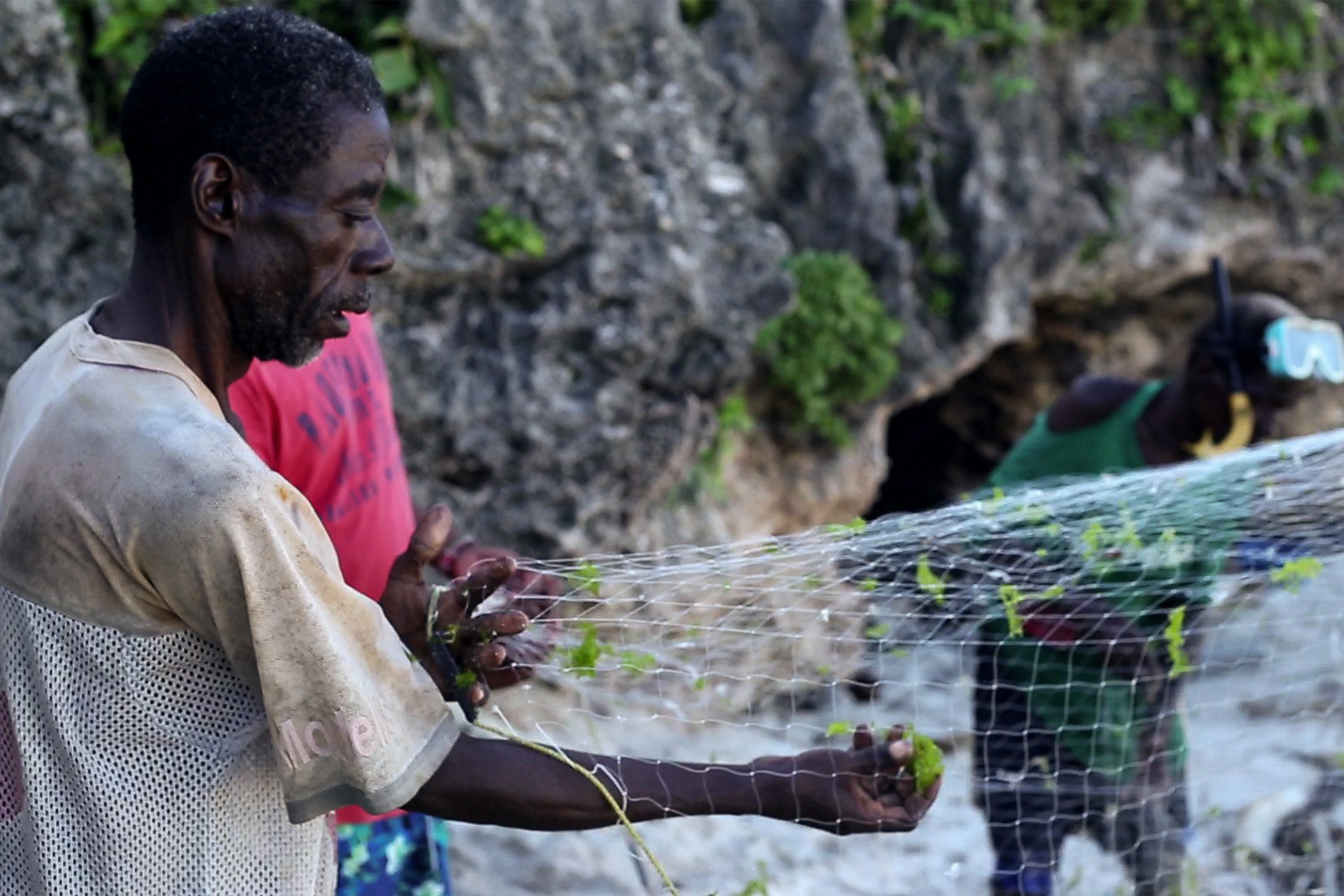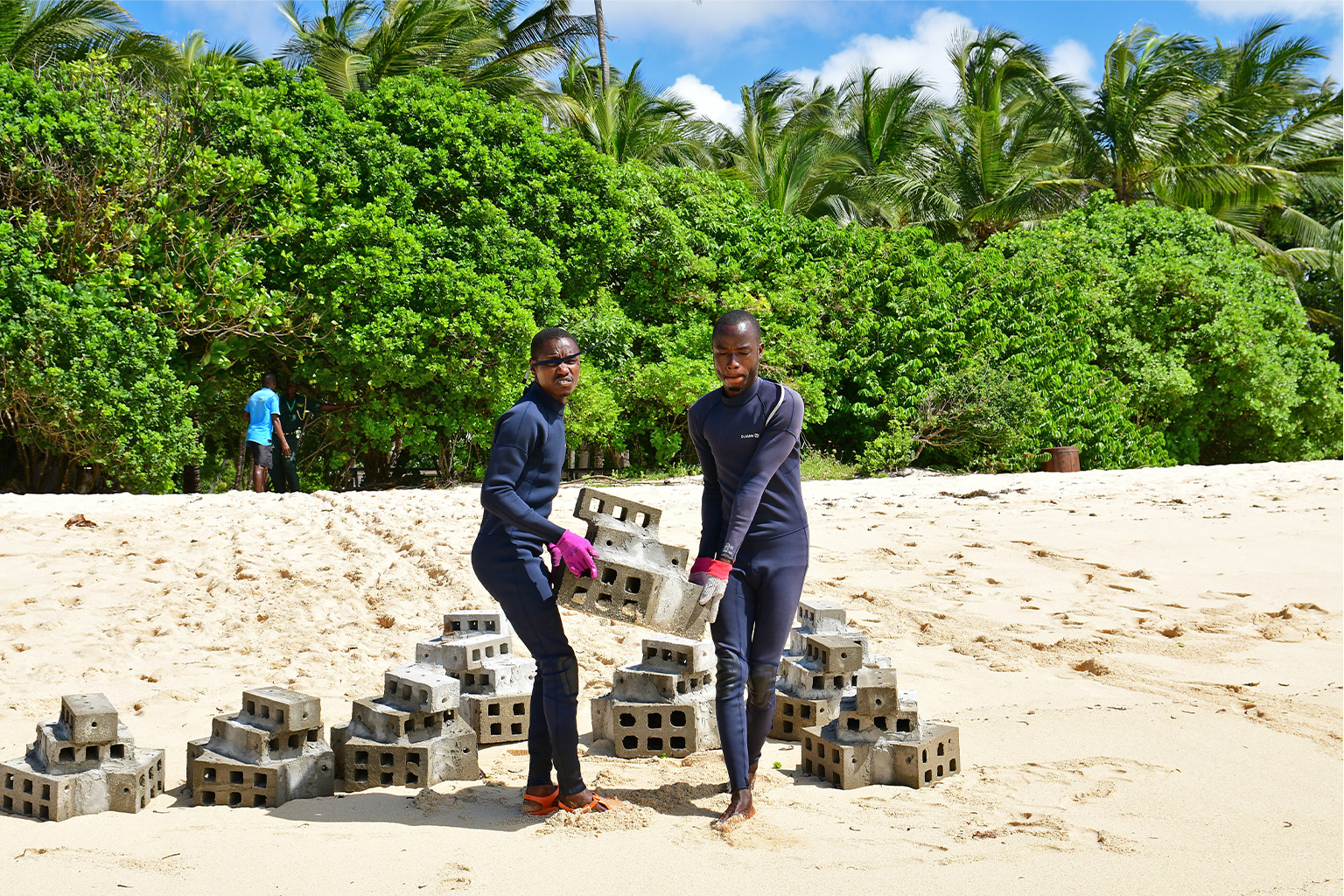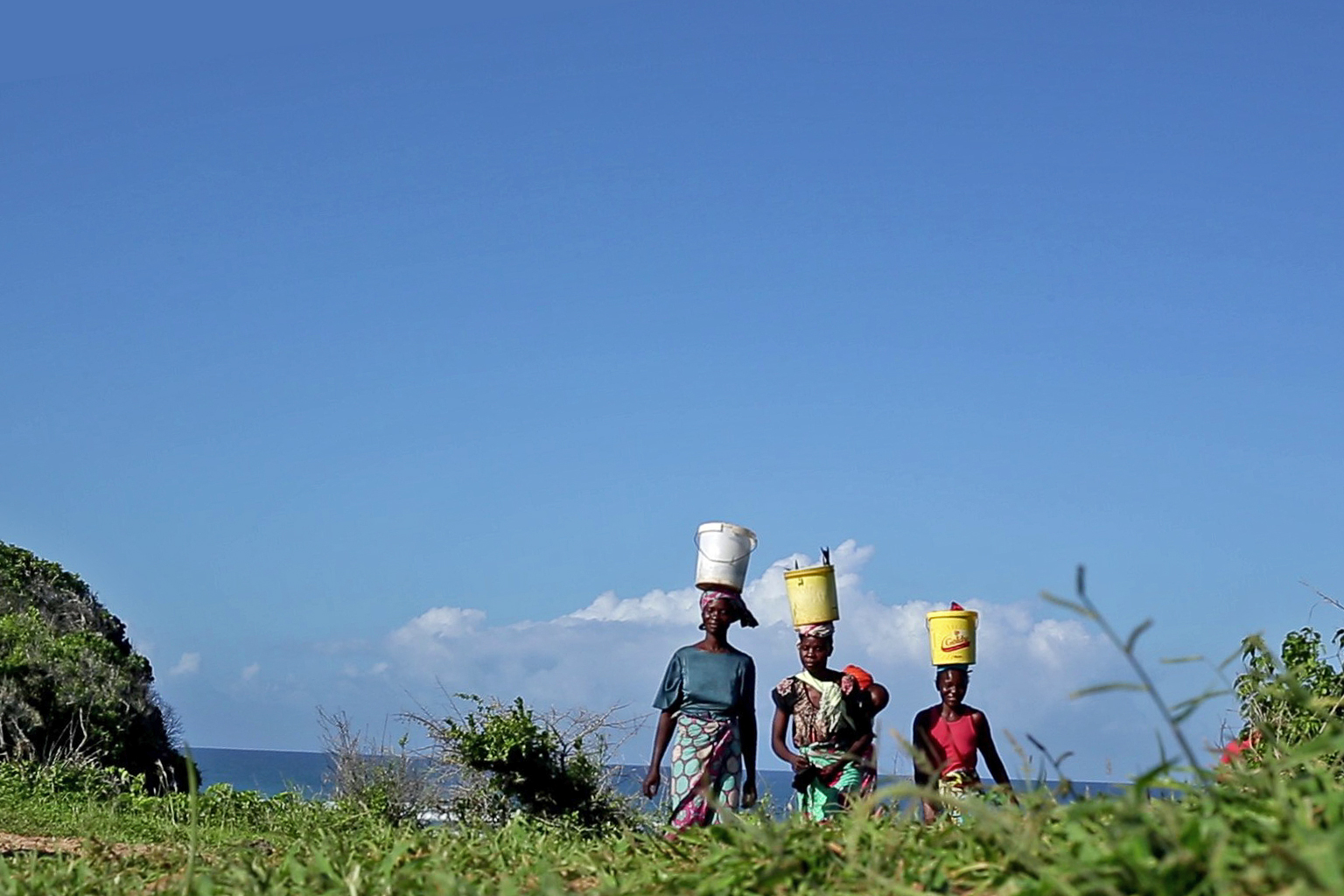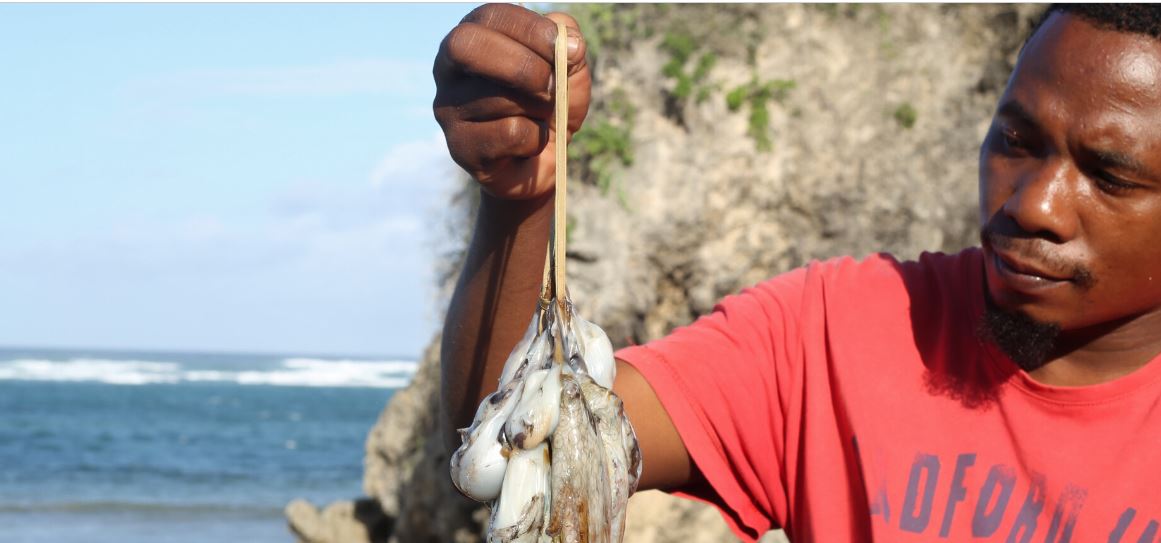- Over the past two decades Kenyan fishing communities have been setting up no-fishing zones called tengefus, Swahili for “set aside.”
- The idea was inspired by the fishing habits of their forebears, who prior to colonization established seasonal fishing closures to ensure plentiful harvests.
- Today there are 22 tengefus in various stages of development in the country, some more successful than others.
- Successful tengefus have seen fish populations and coral cover increase, and they’ve established tourism enterprises that fund community initiatives. To work, experts say tengefus need support from communities, donors and the government.
KWALE and KILIFI COUNTIES, Kenya — One June afternoon at the Mwanamia fish landing site on Kenya’s north coast, Garama Karisa was busy mending his gear for an afternoon fishing expedition. He expertly weaved his threaded needle, perfectly knotting a net composed of neat squares slightly larger than a saltine cracker. Other fishermen sat under a makeshift palm-frond shed facing the sea, bongo music blasting from a radio strapped to the rafters.
When Karisa finished his mending, he and two other fishermen headed out to sea. The fishermen from Mwanamia have no restrictions on where they can fish locally. However, a few kilometers to the south, the community has set aside a 30-hectare (74-acre) swath of sea as a no-take zone where fishing is prohibited. Since it was established 18 years ago, Karisa said he has never fished inside the area.
“We have seen improvement in the quantity of fish that we catch, it isn’t like it was before,” he told Mongabay.
The no-take zone, locally called a tengefu (Swahili for “set aside”), was established following the decline of fish stocks by residents of Kuruwitu, an administrative area with four villages in Kilifi county. The idea was inspired by the fishing habits of their forebears, and it soon caught the attention of conservation organizations and government authorities, who encouraged other communities along the Kenyan coast to set up their own. Almost two decades after Kuruwitu became the first to set up a tengefu, nearly two dozen have sprouted in Kenya, with varying degrees of success.


Kuruwitu’s story
Dickson Juma, a Kuruwitu fisherman, recalled a day in November 2002 when he set out in his canoe to fill an order for 13 kilograms (29 pounds) of fish. But after a long day at sea, what he brought back was insufficient. He promised to fill the order the next day and tried his nets at a different location, but the results weren’t any better.
Juma was not alone. All the local fishermen were facing the same challenge of declining fish stocks, and the problem was common along the Kenyan coast. Local fishers attributed the decline to overfishing caused by an increase in population and the spread of modern fishing equipment. Juma, his client, a local property owner named Desmond Bowden, and other leaders of the fishermen at the Kijangwani landing site in Kuruwitu broached the idea of setting aside part of the sea to allow fish to breed and multiply so they could have enough spilling over into the wider seascape to fill their nets.
“When we started speaking to our fellow fishermen concerning the issue, they supported it,” Juma told Mongabay. “The area chief then called a meeting with the entire community and it was received positively. We then developed our constitution and did elections.” Juma is now chair of the Kuruwitu Conservation and Welfare Association (KCWA), a community-based organization formed in 2003 to represent fishers’ interests and oversee the new tengefu.
That year, funding from NGOs enabled the KCWA to undertake coral restoration within the tengefu, and over time they have introduced tourist activities there. “We saw that while the area was degraded at the time, it had potential to regenerate with conservation,” Juma said.
In 2007, the Kenyan government established beach management units (BMUs), local groups of fishers and fish traders registered with the fisheries department that enable the department to enforce regulations, such as those prohibiting certain fishing methods. The Kuruwitu BMU was established in 2008 to oversee six fish-landing sites spread across Kuruwitu’s four villages, allowing the KCWA to focus solely on the tengefu and other conservation efforts. The KCWA remits 10% of its earnings to the BMU, and the two entities work closely together, with 280 shared members.
Ali Garama, the Kuruwitu BMU chairman, told Mongabay that fishermen occasionally trespass into the tengefu to fish, so the BMU employs guards to patrol it. Even so, he said, the tengefu benefits the fishermen. “Since we established the tengefu and started restoring corals, there has been an increase in fish and the fishermen benefit from the spillover of fish,” he said. Inside the tengefu, studies confirm fish stocks have increased; the New York-based NGO Wildlife Conservation Society (WCS) found an increase in fish biomass of up to 400% by 2014.
Additionally, income generated from the tourist activities, which include snorkeling in the tengefu, deep-sea tag-and-release fishing expeditions, and dhow sailing, goes to supporting the community.

Reviving tengefu
Fishermen along Kenya’s coast agree that their forebears practiced a version of the current tengefu, minus the coral restoration and tourist activities. Katana Ngala, a fisherman and founder-member of the KCWA who now runs the coral restoration program, said traditionally there were seasonal closures and seasonal fishing. “They would go fishing in one area on one day and move to another place the next time and so on,” he told Mongabay.
A 2016 paper, led by Tim McClanahan, a Kenya-based conservation zoologist with WCS who has worked with communities to establish a number of tengefus, says the tengefu system evolved in three phases. In the initial precolonial phase, fishermen practiced closures akin to what Ngala described. “Before colonial times, and up to the 1920s, traditional informal institutions were in place to regulate resource use,” the paper says. “These were upheld by community elders who played a role in granting permission for fishing and mediating conflicts about resource use.”
Colonization by the British brought the erosion of such traditional systems of resource regulation. Subsequent postcolonial governments opened fisheries access, with policies seeking to maximize catch and profits. The third and current phase is characterized by a change in development goals and governance, often toward co-management of marine resources by communities, the government and other organizations, according to the paper. Community management takes various forms in Kenya, including locally managed marine areas, community conservation areas, and tengefus, it says.
Most tengefus are in coral reef areas, but can be established in any marine ecosystem, including mangroves or rocky shores, and fishers have different reasons for agreeing not to fish there, Joan Kawaka, a community-based conservation project manager at the Mombasa-based NGO CORDIO East Africa, told Mongabay. Tengefus, gear restrictions and seasonal closures are all management measures that fishers can choose to adopt within co-management areas, she said.

A range of outcomes
Along Kenya’s coastline, tengefus offer hope for community-centered marine conservation — if they can be replicated widely and managed well. There are 22 tengefus in various stages of development in the country, according to the Kenya Marine and Fisheries Research Institute (KEMFRI). In addition to Kilifi county, several BMUs have established tengefus in Kwale and Lamu counties to the south and north of Kilifi respectively, with varying degrees of success.
In Kwale, the BMUs in Mkwiro, Kibuyuni and Wasini Island all have their own tengefus. The latter, called the Wasini Community Conservation Area, was established in 2005, a few months after the Kuruwitu tengefu. Like Kuruwitu, it runs businesses offering tourist activities and uses the proceeds to support community needs like paying school fees and renovating and equipping the local school and health clinic.
“An NGO promised to fund us [to] develop a conservation project and we had an area with corals,” Feisal Abdalla, a founding member of the Wasini tengefu, told Mongabay. “Tourists used to go far to Kisite Marine Park to snorkel and we saw it as an opportunity to have a snorkeling site nearby. We decided to close the area, earn an income from the tourists who snorkel there, and the community would benefit.”
Victor Mwakha, a KEMFRI scientist, said he believes well-run tengefus have a positive impact on conservation. “They are impactful in terms of maintaining biodiversity and fisheries,” he told Mongabay. “These are areas that were previously productive but had over time undergone degradation.”
But Mwakha also said individual tengefus’ survival and impact depend mostly on donor funding. The KCWA, which in 2017 won the U.N.’s prestigious Equator Prize, has had support from a number of donors. Oceans Alive Trust, a Kuruwitu-based organization that KCWA-co-founder Bowden started in 2017, has provided technical support; WCS, Nairobi-based East African Wildlife Society and CORDIO East Africa, among others, have provided funding at different times.
“Some of them are impactful but some are not depending on their management and the support and follow-up provided by the government and NGOs,” Mwakha said of the tengefus. A 2015 study McClanahan co-authored found large increases in fish biomass a few years after the establishment of two tengefus, including Kuruwitu, but only a small increase or none at all at three others.

While residents of Kuruwitu and Wasini seem happy with their tengefus, not all coastal communities have been enthusiastic. Kilifi county is a case in point. Of the 17 BMUs there, only two besides Kuruwitu BMU have seriously explored setting up tengefus in their areas. Members of the Takaungu BMU visited Kuruwitu to learn more about the process. However, upon returning to set up their own, some members expressed opposition; they have yet to agree how to proceed. The As a result, plans for more tengefus in Kilifi have stalled.
Still, there are signs minds may be changeable. When Henry Mzungu was vice chairman of the Kilifi Central BMU in 2017, he opposed plans to introduce a tengefu. He’s now the BMU chair and knows better, he told Mongabay, but the majority of the BMU’s 600-plus members still oppose the idea. Mzungu said his members need more information about tengefus, as well as some practical assistance before they can commit, because it would entail a big disruption to their livelihoods.
“If fishermen will be supported with fishing gears to be able to carry out deep-sea fishing, which we normally don’t get to, and therefore leaving nearshore areas for tengefus, that is possible,” he said. “However, the fishermen need to be persuaded and alternative gear provided for them.”

